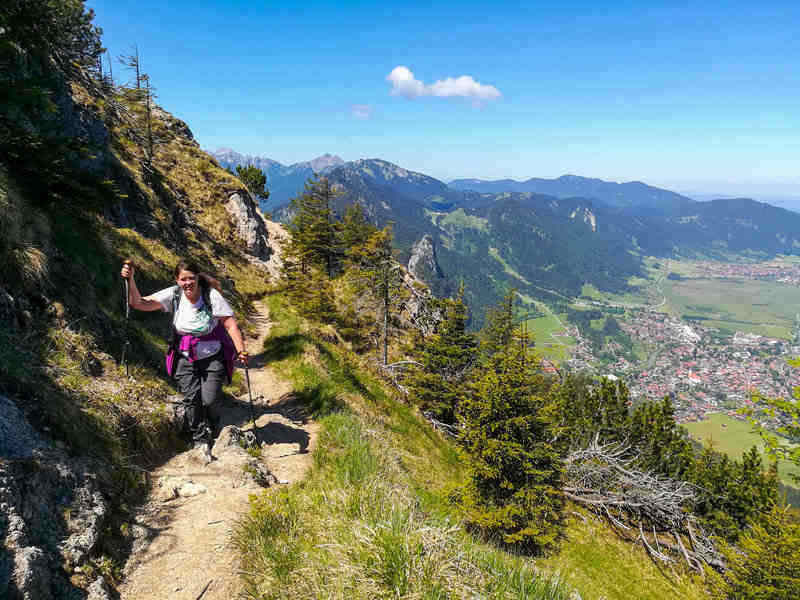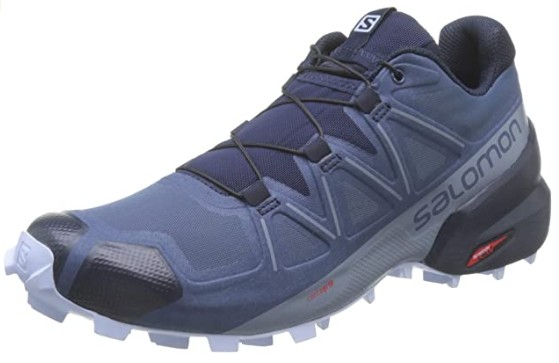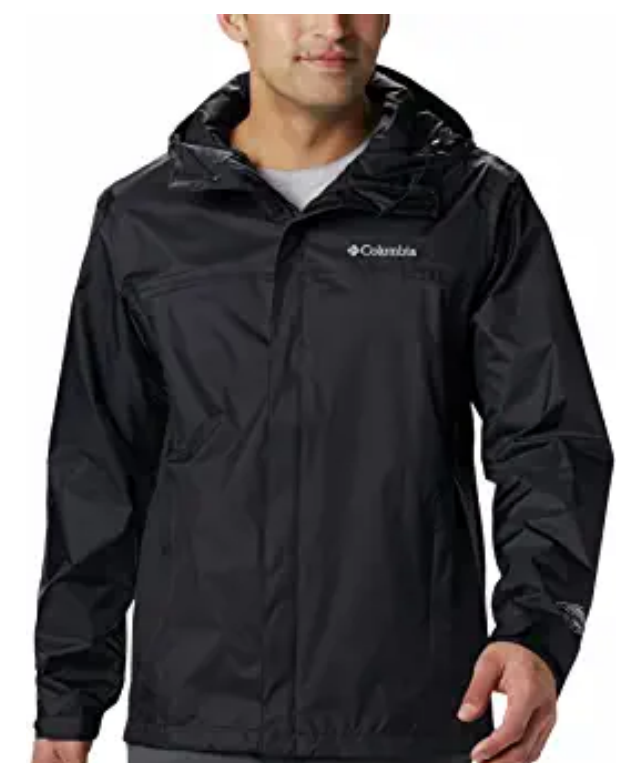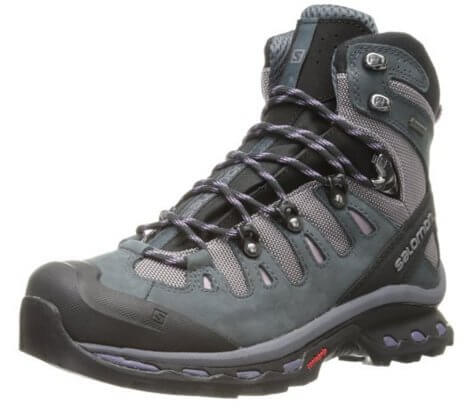Check out our day hiking packing list. Find out the essentials to bring on your hike, plus optional hiking gear that may make your hike more comfortable.
Table of Contents
If you’re new to hiking, it can be difficult to know what to pack and what to leave at home. I’ll never forget the time I saw an ill-advised tourist hiking in the Canadian Rockies – wearing gumboots!
You can’t make this stuff up! Apparently, someone had told him it was going to rain, so he thought gumboots were the solution. Unsurprisingly, his feet were covered in blisters. I gave him some Compeed for the worst ones – ouch! He clearly hadn’t read my day hiking packing list essentials.
I’ve also ran into hikers who begged for water on numerous occasions. In each case, they had attempted a long hike with not enough water.
That’s when things start getting scary. If you get lost and end up spending the night in the mountains, you can die from hypothermia. It’s not uncommon for temperatures to drop below freezing in the mountains overnight – even in summer! Don’t worry, that’s not going to happen to you. Once you know what to pack for a day hike, it’s easy to stay safe and not overpack.

Who Designed This Day Hiking Packing List?
My name is Laurel and I’ve been hiking almost every weekend for over 20 years, plus at least one multi-day hike every year. I also offer hiking tours and advise clients on what to pack for their hikes.
My day hike essentials have evolved over time and continue to do so as new products and technology come out. When I first started hiking, fleeces were really thick and bulky. I’m so glad to see how hiking gear has evolved to become lighter without sacrificing warmth.
As I hike almost every weekend, sometimes doing multiple hikes on a weekend, I’ve learned what to pack and what to leave at home.
Recommended Reading: 42 Gifts for Outdoorsy People: Outdoor Gift Ideas for Every Adventurer
Day Hiking Packing List:
When hiking, it’s essential to layer so that you can easily add or take off layers as you sweat or as the temperature changes.
The three essential layers are:
- Base layer: for wicking sweat off your skin. I LOVE Merino wool as a base layer but quick-drying polyester will also work and is cheaper. Never wear cotton, you’ll be too hot or too cold.
- Mid-layer: this is for insulating and helps your body retain heat. I always bring a mid-layer even in summer, since temperatures can drop very quickly. I have a lightweight one for summer and a warmer fleece for winter.
- Outer layer: this is a shell to protect you from wind and rain. I always bring an outlet layer, even on sunny days. Weather can change quickly, and it can often be cold and windy at the summit.
Thermal Shirt
I wear this in winter, spring, fall and sometimes even in summer on a cool day. I highly recommend wool. IN summer, I wear a short sleeve version of this.
Don’t worry you can get wool that’s actually soft and not scratchy. It keeps you warm, and best of all, it doesn’t stink afterwards!
Quick Dry Shirt
This optional shirt comes in numerous different styles, but I like the kind with roll-up sleeves. That way it’s easy to adjust according to the weather.
I’d typically only wear this for summer hiking in place of a base layer.
Lightweight Fleece
This is your mid-layer. I bring one on every single hike – even if it’s hot outside. You never know when the weather will change. The new versions are light, hardly take up any room and are warm.
Waterproof Shell
This stays in my backpack. It doesn’t take up much room and is lightweight. It will save you in rain, hail or even a snow storm. I’ve encountered several snow storms in the middle of summer!
Thermal Leggings
I like to either wear these or bring them with me in winter hikes, spring, and fall. I don’t wear them or bring them with me when hiking in summer.
Convertible Hiking Pants
These are my favourite essential item of hiking gear. They are full length pants that zip off at either just below the knee and/or also zip off above the knee, turning them into shorts, depending on the style. I almost never hike in regular shorts. These are much more practical should the weather change.
Related Reading: 18 Best Leggings for Hiking
Waterproof Pants
These are worth buying and then you can assess before each hike whether or not to bring them. If rain is in the forecst, then obviously bring them.
If the forecast is for sun, I don’t usually bring mine for day hikes of 4 hours or less, but will bring them on longer day hikes.
Hiking Shorts
If you are hiking in warmer weather then shorts are an acceptable option. However, I still prefer the convertible hiking pants mentioned above. These offer some great pockets so you can keep your necessities close by.
Hiking Socks
Socks are one item you don’t want to cheap out on. A good pair of socks will help prevent blisters by wicking the moisture away. They’ll also help regulate your foot temperature. All it takes it getting a bad blister once for you to be convinced of the value of a good pair of socks. Trust me, don’t learn the hard way.
Gaiters
These are always in my backpack and are an essential in my opinion if you’re doing difficult hikes with scree. Howeverif you’re hiking at lower elevations on a wide path, you probably don’t need them. Having said that they’re great in snow and mud for keeping your legs warm and dry. They’re also good in summer on scrambles. They keep tiny rocks from getting in your boots. Besides, even in summer, you may encounter mud, or even snow higher up! They also add another layer, so can be used if you’re cold.
Hiking Boots
You’ll want to invest in a good pair of hiking boots. Your feet will thank you for it. I always buy a 1/2 to 1 size bigger, since your feet swell after a day of hiking. I recommend trying them on near the end of a day, when your feet are already swollen.
If you have weak ankles, I’d definitely recommend hiking boots over hiking shoes for extra support.

Buy on Amazon
Trail Runner
If you are not one for hiking boots and are hiking on easy trails then trail runners are a good option and they’re lighter than hiking boots. If you are looking for light shoes that are versatile and still have traction then these would be great for a day hike.
Related Reading: The Best Hiking Footwear For Every Hiker
Neck Warmer
As silly as it sounds, a neck warmer is in my backpack on every hike – even in summer. It can also be used against the wind.
Baseball/Sun Cap
You definitely don’t want to get sunstroke while hiking so bring some kind of hat that will protect you from the sun.
Hiking Hat
If you prefer wide brimmed hats to caps then this is the perfect one to pack for a day hike. I particularly like this one because it caters to women with long hair.
Merino Beanie
When hiking in colder areas, a good Merino wool beanie is perfect. This one offers moisture wicking which makes wearing it a little more comfortable as you are bound to sweat even if it is cold.
30L Backpack
This size will cover you for day trips. Look for one that has a built-in rain cover. It will fit better than if you buy one separately. Also, buy one that has space between the pack and your back to prevent back sweat. It can be uncomfortable and can have a huge impact on your body temperature. I’m a big fan of Deuter backpacks.
20L Backpack
If you are looking for something slightly smaller, then a 20L is perfect. You can add in a hydration bag if you need to. This is perfect for a shorter day hike.
Related Reading: Best Hiking Backpacks: Our Top 13 For Every Budget
Base Layer
This Merino wool base layer is the perfect addition for any hiking trip. I don’t usually pack it unless I am planning to do a more strenuous day hike. Merino wool is incredibly comfortable and gives you a little extra warmth especially in cooler weather.
Sports Bra
Obviously, this one is for women only. Ladies take care of your girls while staying comfortable – enough said!
Day Hike Essentials: Hydration & Food
On a longer day hike it is always a good idea to take an extra bottle. Depending on where you’re hiking, you may want one that can purify water so that you can collect water on the trail if needed. The Life Straw purifies water so you don’t have to worry abut bacteria and other impurities from water sources along the way.
2-4L Water
Always bring more water than you think you’ll need. Yes it’s heavy, but it’s free. You may go through more than you think you will. I bring a minimum of 2 litres on everyday hike, and sometimes up to 4 for longer hikes, or if it’s hot. You may be able to find a stream or lake to drink water from, but don’t count on it. And remember, if you do, you’ll need either purification tablets or a filter.
Electrolyte Tablets
These stay in my First-Aid kit. If you feel light-headed, dizzy, or have low blood pressure, these can make you feel better in a flash.
Energy Bars
Energy bars are another great food source on the trail. I always keep one or two as an emergency stash in my backpack.
Dried Fruit
Fruit leather is the perfect snack to have on a hike. Sweet, fruity and easy to eat, I love adding these as a treat.
Snacks
What to eat when you’re hiking could be a whole post in itself, but bring more food than you think you’re going to need. Nuts, seeds, trail mix are all good choices.
Safety Items for Your Day Hiking Packing List
Emergency Thermal Blanket
This is tiny, but may save your life if you get stranded on the mountain since hypothermia is a real risk if you unexpectedly end up having to spend the night on a mountain. I never hike without one.
Mini First Aid Kit
For day hikes you probably don’t need a full-size First Aid Kit. I use a mini one like this one which has the basics.
Day Hike Essentials for Avoiding Blisters When Hiking
The two best ways to avoid blisters when hiking are:
1) have hiking boots/shoes that fit correctly. See the tips above under hiking boots for how to find the right size.
2) wearing breathable socks that wick moisture away helping to prevent blisters.
If you do feel that you’re starting to get a blister, treat it as soon as possible by applying Compeed Anti-blister stick. Don’t wait. And if it does develop into a blister then apply a Compeed blister cushion.
Anti-Blister Stick
Bring instant comfort to those spots that feel like they are going to blister, especially on a hike. I always keep this is in my day pack.
Compeed Blister Cushions
I think Compeed is the best blister treatment on the market! I always carry a few in my backpack.
Navigation Essentials For Your Day Hike
iPhone
I highly recommend downloading the GPS tracks of your day hike into an app such as Gaia, before you go hiking to ensure that you don’t get lost. While you can bring another GPS device, I prefer a smartphone since you can also use it to take photos on your hike.
Map
Always bring a paper copy of a map and a description of your hiking route. It’s fine to use hiking apps/electronic versions, but bring a paper one as a backup in case the electronic version fails.
Miscellaneous Items for Your Day Hiking Packing List
Headlamp
I always carry a headlamp in my backpack, even on short hikes. You can get lost, injured and find yourself unexpectedly hiking in the dark.
Paracord Bracelet
This is an optinal items for those that like to be prepared. It’s a rope and a compass. This is the easiest and most compact way to carry it.
Toilet Paper
If you’ve ever been without toilet paper while hiking, you’ll understand why you should always bring a roll with you.
Plastic Bags
While you can bury your business, you really should carry out your used toilet paper. Yes, it’s stinky and gross, but do it anyway.
Bear Spray
If you are hiking in bear country then you should carry this with you. at all times.
Bug Spray
This is a small item to carry and is essential in my book.
Sunscreen
Sun protection is really important.
Sunglasses
Sunglasses are a must on the trail. I never go on a hike without them.
Related Reading: Gifts That Hikers Will Love
Optional Items for Your Day Hiking Packing List
Cooling Towel
A cooling towel is an optional item when you are hiking in warmer weather.
Wipes
Cleansing wipes can be useful if you want to freshen up but aren’t essential. I love that these are biodegradable
Hiking Poles
I don’t recommend buying hiking poles if you are just starting out. But for avid hikers, poles can come in handy on a trail.
Waterproof Phone Case
Having a waterproof case for your phone on a hike can be a great asset.
Related Reading: The Best Trekking Poles.
After Day Hiking Items
Foot Roller
I don’t actually bring this with me for day hikes, although I do for multi-day hikes, but I have it at home for after the hike. It feels soooo good!
Guasha Tool
I love using my Guasha tool on sore muscles, particularly on my shins, calves and feet after. along hike. You rub it firmly along the sore spot 5-10 times. It hurts but feels SO good afterwards.
You’ll also want to check out our tips on how to reduce muscle soreness after your hike. The tips we’ve included here make a HUGE difference.
Now that you know what should be in your day hiking packing list, it’s time to get to the fun stuff – the actual hiking! Have a great day of hiking.















































